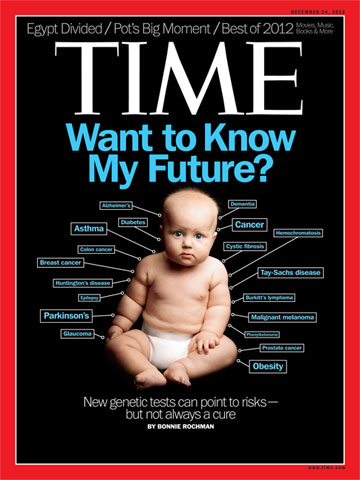
(2 of 6)
The mapping of the human genome, completed in 2003, cost $2.7 billion. Now the cost for an individual's whole-genome sequencing (WGS) is $7,500 and falling fast. One day WGS could be as easy to get as a pregnancy test at the drugstore. To do the testing, lab technicians need less than a teaspoon of blood, which is chemically treated to burst open the cells so the DNA inside them can be collected. Those microscopic strands are then fed into sophisticated machines that read each of the 3 billion bits of information, called base pairs, that make up a person's genetic alphabet. Computers scan the data for the equivalent of spelling mistakes. Some mistakes cause disease; others don't. And in between is a vast gray area where scientists just don't know what the changes mean.
In an ideal world, genetic analysis could save money by catching diseases early, offering targeted treatments and identifying the most effective preventive measures. Dr. Katrina Armstrong, a professor at the University of Pennsylvania School of Medicine, notes that testing 21 genes could reveal which breast-cancer patients are unlikely to benefit from a particular chemotherapy--knowledge that could spare women the treatment and save $400 million each year. "If genomics can help us understand who will get the most benefit and who will get little or no benefit from an intervention," Armstrong says, "it will take us a long way toward improving patient outcomes and saving money."
But a majority of doctors in a recent survey predicted that more testing will trigger higher costs, as patients with ambiguous results begin to seek frequent screenings--and potentially unnecessary procedures--for diseases they might never develop. "If we open the door to a test that has no clear, well-defined purpose, that is a recipe for unnecessary medical care," says Dr. Wylie Burke, a geneticist who chairs the department of bioethics and humanities at the University of Washington. "Instead, we could say, Here are the 1,000 mutations we should check in everyone." The American College of Medical Genetics and Genomics is already working on that, painstakingly assembling a list of a few dozen conditions that it says should be routinely looked for during genome sequencing. The hope is that focusing on certain hot spots--contenders include several syndromes that increase the risk of various cancers--will lead to improved analysis and, with it, better patient outcomes.
Some genetic testing has already moved out of the lab and into the living room. Companies like 23andMe offer DNA analysis directly to consumers--no doctor required. Since 23andMe's founding in 2006, more than 180,000 people have been tested as the price has fallen from $999 for information on 14 specific traits and health risks to $99 for more than 200. The promise boils down to "forewarned is forearmed." If parents learn that their child carries a gene called ApoE4, indicating a higher risk of Alzheimer's, they might discourage the child from playing youth hockey or football, since research has linked traumatic brain injuries with a greater likelihood of brain disease in people who test positive for ApoE4.
